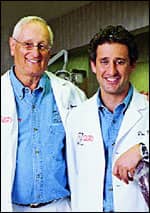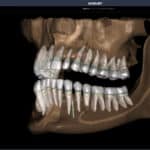With Gary Opin, DMD, MDSc, and Perry Opin, DDS, MScD

Opins: There are passive and active self-ligating brackets, and they both have advantages and disadvantages. In the initial stages of orthodontic treatment you want teeth to be able to move freely, so you want to create minimal friction.
As with any other orthodontic bracket, self-ligating brackets allow you to choose the type of wire and the ideal force levels that will be most efficient in the early stages for rotating, tipping, and leveling. You can enable the teeth to move in a rapid and efficient manner with low forces, allowing the most efficient biologic cellular changes.
With passive brackets, you simply insert a smaller wire to create less friction early on in treatment, which is very good for freedom of movement. With the correct wires, self-ligating brackets are superior to the effects of standard ligatures for early-stages treatment because there is always less friction and more consistency in tooth movement in a self-ligating system.
The active self-ligating bracket with rectangular wires offers three-dimensional control and more consistent and finer finishing.
OP: Why is there controversy over passive versus active mechanisms, and on which side of this debate do you fall?

Enhanced hygiene is also an enormous benefit: elastomeric ligatures are food traps that absorb fluid and plaque and attract bacteria, all of which can exacerbate decalcification and gingival swelling.
OP: If an orthodontist were just starting to use self-ligating brackets, what tips would you offer him?
Opins: You must be comfortable in what you’re doing. Schools are now teaching more about self-ligation, and this is the best source of non-prejudicial information. There is definitely confusion and apprehension about which type to use, and we’ve seen this in the past as new technologies are introduced.
We’ve been using self-ligation for nearly 30 years, and have used many different types, with active brackets proving to be more consistent in correcting tip, torque, and rotation.
The ideal self-ligating bracket system uses a bracket that can be both active and passive. The reason for this is that the initial leveling and rotational correction of a malocclusion is much more effective with minimal friction. Finish, however, is a whole other story, and that works best with active brackets.
Reduced chairtime is a hugely overlooked advantage of self-ligating systems, considering chairtime is one of the biggest—if not the biggest—expenses of a practice. With the clip built into the mechanism, you simply close the bracket to activate the self-ligating properties. There are no steel ligatures to tie in, and no elastic ligatures that need to be changed every visit.
Orthodontics is a combination of art and science in terms of managing how different malocclusions react to the same treatment. One advantage of self-ligating brackets is that you can use the same mechanics you’ve used previously. Finished results are more consistent, even quicker, and better using some of the new wires and biomechanical principles.
Gary Opin, DMD, MDSc, and Perry Opin, DDS, MScD, are in private practice in Millford, Conn. They can be reached at (203) 878-5750.









